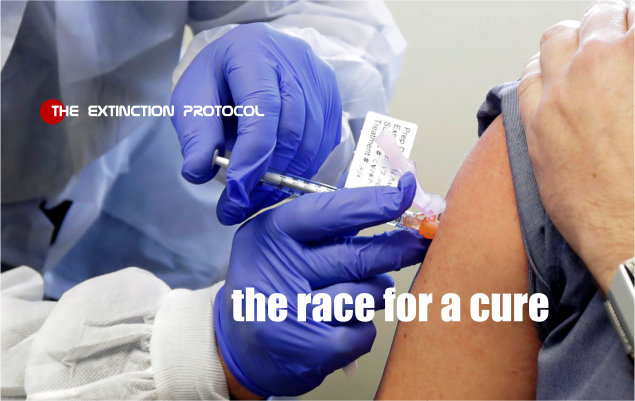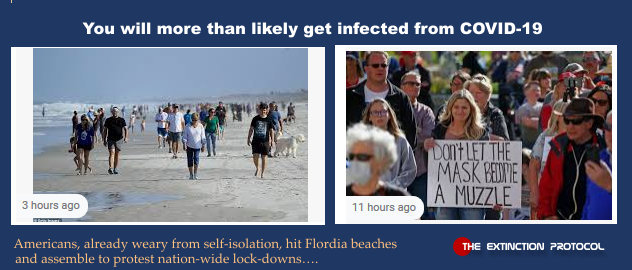U.S. deaths top 40,000 as vaccine hopes fade – and Americans are left with a grim new reality: the worst is yet to come

As of April 19, 2020, there are at least 755,533 cases of coronavirus in the United States and at least 40,461 deaths, according to Johns Hopkins University’s tally. The total includes cases from all 50 states, the District of Columbia and other U.S. territories, as well as all repatriated cases.
Humanity will have to live with the threat of coronavirus “for the foreseeable future” and adapt accordingly because there is no guarantee that a vaccine can be successfully developed, one of the world’s leading experts on the disease has warned. The stark message was delivered by David Nabarro, professor of global health at Imperial College, London, and an envoy for the World Health Organization on Covid-19, as the number of UK hospital deaths from the virus passed 15,000.
A further 888 people were reported on Saturday to have lost their lives – a figure described by community’s secretary Robert Jenrick as “extremely sobering” – while the total number who have been infected increased by 5,525 to 114,217. The latest figures, which do not include deaths in care homes and in the community, put further pressure on the government amid continuing anger among NHS workers and unions over the lack personal protective equipment (PPE) for hospital and care home staff on the front line. In late March the government’s health advisers said that if UK deaths from Coronavirus could be kept below 20,000 by the end of the pandemic, it would be a “good result” for country. But with an estimated 6,000 people having already died in care homes from Covid-19 – a figure not included in Saturday’s official tally – the 20,000 figure is likely already to have been exceeded.

In an interview with The Observer Nabarro said the public should not assume that a vaccine would definitely be developed soon – and would have to adapt to the ongoing threat. “You don’t necessarily develop a vaccine that is safe and effective against every virus. Some viruses are very, very difficult when it comes to vaccine development – so for the foreseeable future, we are going to have to find ways to go about our lives with this virus as a constant threat. “That means isolating those who show signs of the disease and also their contacts. Older people will have to be protected. In addition, hospital capacity for dealing with cases will have to be ensured. That is going to be the new normal for us all.” –The Guardian
THE 2ND WAVE: Even before the first horrific phase of the COVID-19 pandemic has run its course, scientists are worried about the second wave of the disease. It could crash worse than the first, killing tens of thousands of people who did such a good job of sheltering in place they remain virgin ground for the virus. Or it could be a mere swell, with so many people having been infected without symptoms that levels of immunity are higher than realized. There is no crystal ball to look to, because so many crucial pieces of information remain missing.
Are people who’ve had COVID-19 immune? How long does immunity last? Will the virus play out like influenza and the common cold, peaking during cooler months and falling during warmer ones? Is its deadly path undeterred whatever the weather? Until there’s a vaccine “it’s unfortunately not unlikely that we may see a second wave or even a third wave,” said Peter Marks, director of the U.S. Food and Drug Administration’s Center for Biologics Evaluation and Research, which oversees vaccines. “I shudder to think of that, but I think we have to be realistic.”
Grim prognosis: Americans should understand that life will never return to normal unless the country achieves “herd immunity” (which could result in over 100,000 more deaths) and or the U.S. develops an effective vaccine to stop the transmission of the virus – However; both of these scenarios are practically inconceivable at the moment.
The first question on every doctor’s mind is whether someone who has had COVID-19 is immune, and if so for how long. People who’ve had mumps are immune from it for life. Versions of the common cold caused by different types of coronavirus see immunity wane within a year. Variations are wide. COVID-19 is such a new disease that there is no solid data on the immunity of survivors. But given its similarities to coronaviruses such as severe acute respiratory syndrome (SARS) and Middle East respiratory syndrome (MERS), it’s expected to convey at least some immunity. That’s good news because so many people have contracted COVID-19 from SARS-CoV-2, the virus that causes the disease. Many more probably have had it asymptomatically and didn’t know. Both groups likely have some immunity. –USA Today

You will likely get infected: The Harvard epidemiology professor Marc Lipsitch is exacting in his diction, even for an epidemiologist. Lipsitch predicts that within the coming year, some 40 to 70 percent of people around the world will be infected with the virus that causes COVID-19. But, he clarifies emphatically, this does not mean that all will have severe illnesses. “It’s likely that many will have mild disease, or may be asymptomatic,” he said. As with influenza, which is often life-threatening to people with chronic health conditions and of older age, most cases pass without medical care. (Overall, about 14 percent of people with influenza have no symptoms.)
Lipsitch is far from alone in his belief that this virus will continue to spread widely. The emerging consensus among epidemiologists is that the most likely outcome of this outbreak is a new seasonal disease—a fifth “endemic” coronavirus. With the other four, people are not known to develop long-lasting immunity. If this one follows suit, and if the disease continues to be as severe as it is now, “cold and flu season” could become “cold and flu and COVID-19 season.” –The Atlantic

Comments
Post a Comment